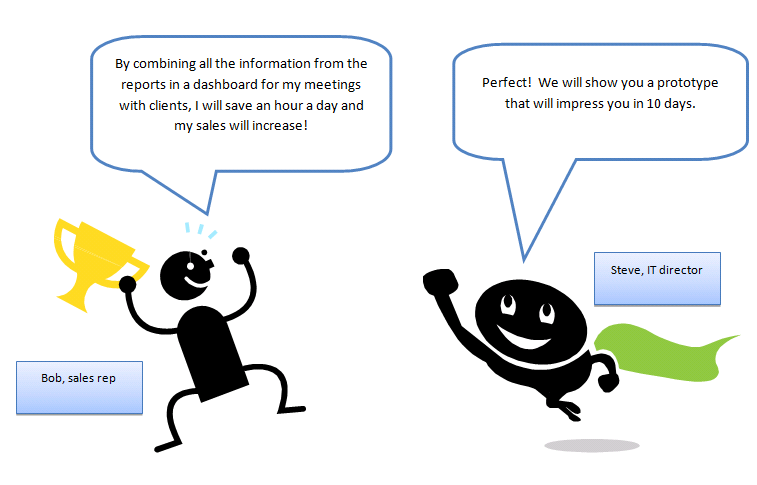In the beginning, before implementing a dashboard solution, you have to make sure the new ideas will “stick” together. On this matter, the excellent book from Chip and Dan Heath “Made to stick” is the perfect inspiration. Basically, the ideas must meet the S.U.C.C.E.S. principles. Let’s apply those principles to a sales dashboards project for example…
(S) SIMPLE
Make sure the sales team (sales manager, representatives, account managers, etc.) is involved early in the definition of concrete and simple benefits. It is better to have a simple and reachable goal than a complex and unrealistic one.
Ex.: “The goal for this project is to increase our sales.”
How much? How? Using what strategy? It is not important for now. The objective here is to make sure everyone knows the goal is to increase the sales. They can all suggest ideas to reach this goal.
(U) UNEXPECTED
Get off the beaten tracks: don’t focus on the usual patterns of ideas. Try an unexpected approach for instance… People are expecting examples of dashboards and standard functionalities early in the process. Resist the temptation…
Ex.: Organise a meeting where you are on the “listen” mode. Give free hand to the imagination and creativity of your sales team.
The first prototypes presented to them will already include their ideas and will much likely be approved almost immediately.
(C) CONCRETE
Avoid verbiage! Improving the performance of the sales team may be a logical strategic goal; but for a rep meeting a retailer on Monday morning, it is not easy to accomplish.
Ex.: “The goal for this phase is to increase the sales by positioning 3 new specific products at our client’s store.”
That’s a clear and concrete goal!
(C) CREDIBLE
Establish the credibility of the project from the beginning. All must see that the project is essential and will be beneficial.
Ex.: “Many studies showed that the leaders of the industry, our most renowned clients, have increased their sales by implementing better data analysis strategies.”
(E) EMOTIONAL
Make sure the individuals understand the importance of the project and feel involved (emotionally to, if possible…).
Ex.: “You won’t have to read reports where essential information is hard to find all the time; which means less stress and more time to talk with your clients. You will miss fewer details that could make you lose sales. Your clients will see your approach as more professional.”
(S) STORIES
Without a doubt the most interesting principle. If the participants can outline the functionalities and benefits of the project by telling a short story, you know everyone is on the same page. Each member of the team should be able to tell his/her story.
Here is an example for a rep: “Every month I am given a 2” binder that contains the reports of all sales. Everyday around 6 am, I eat breakfast before I meet with my clients and I take the reports I need out from this binder. I highlight the important information, combine the data of several paper reports and sum up what I need to talk about with my clients in my little notebook. If I need additional information I call the office and they give me the missing details.
In 3 months when the project is over, I will be able to get an outline of my client’s situation from my home in 1 minute and print it. This dashboard will give me all the information I currently combine from several reports in a one-page summary. I will save at least 1 hour of clerical work each day. Moreover, this dashboard will allow me to see if there were any lost opportunities in the last months for the clients I will visit during the day.
Significant developments in technologies could have been avoided in several fields if the non-adoption situation had been considered a risk factor. By involving people from the beginning and making sure the ideas and benefits stick to all, the barrier of adoption collapses and we get a win-win situation.



